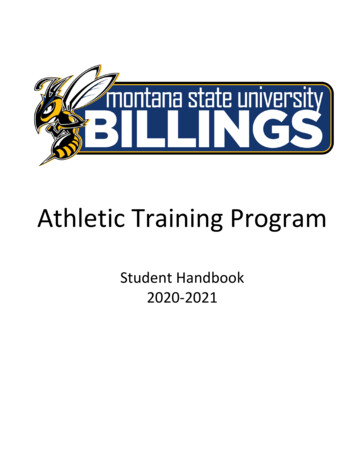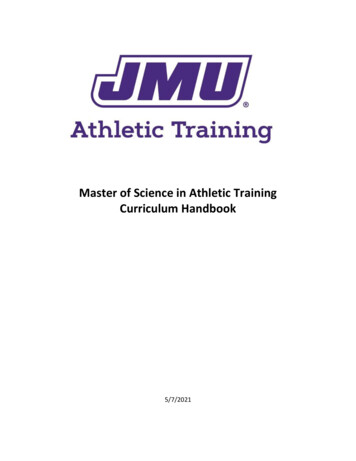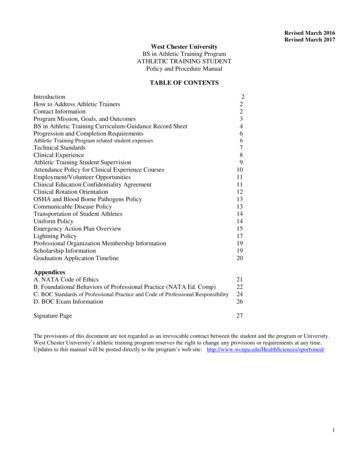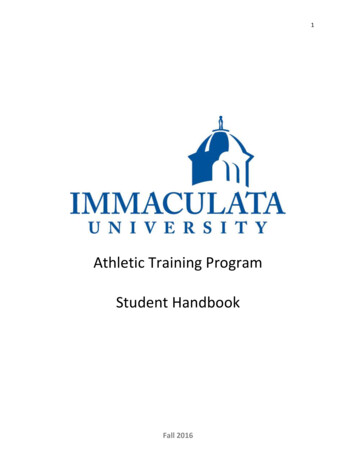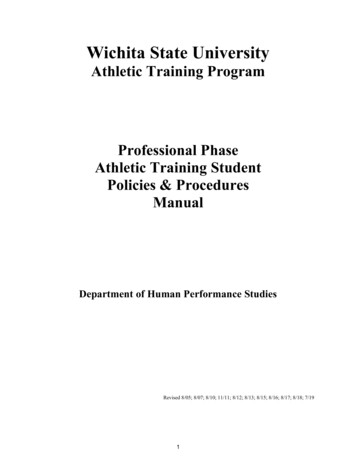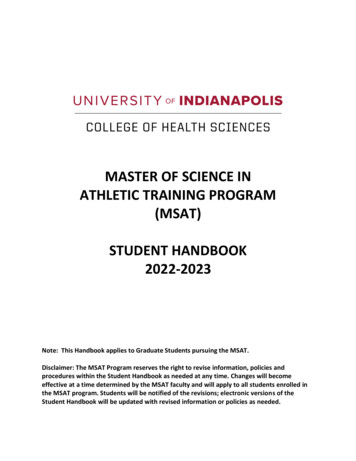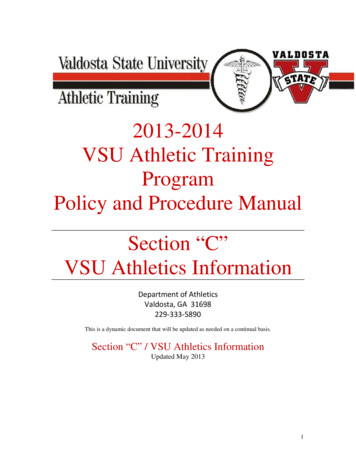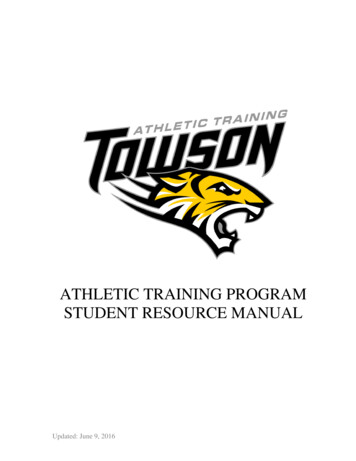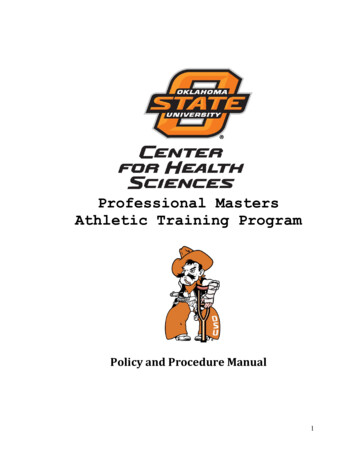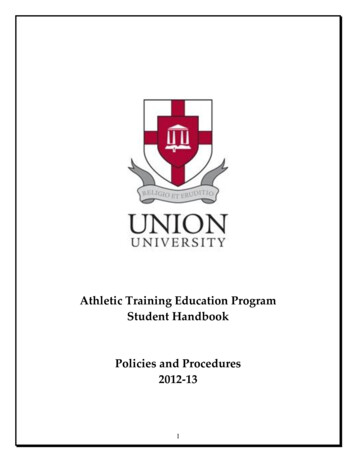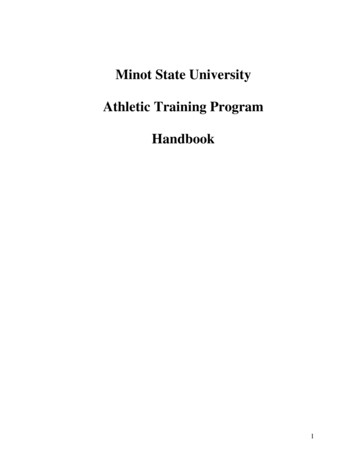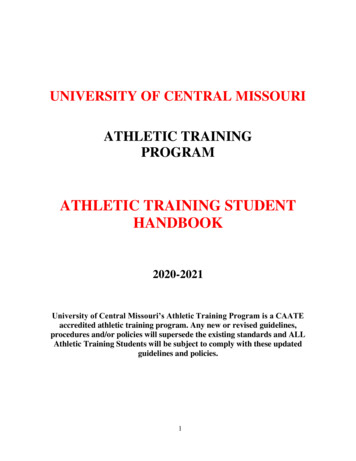
Transcription
UNIVERSITY OF CENTRAL MISSOURIATHLETIC TRAININGPROGRAMATHLETIC TRAINING STUDENTHANDBOOK2020-2021University of Central Missouri’s Athletic Training Program is a CAATEaccredited athletic training program. Any new or revised guidelines,procedures and/or policies will supersede the existing standards and ALLAthletic Training Students will be subject to comply with these updatedguidelines and policies.1
SectionSection I: Introduction toAthletic Training and UCMSection II: AcademicProgram Policies andInformationSection III: ProfessionalBoundary PoliciesSection IV: ProfessionalExpectations andRecommendationsSection V: Policy andProcedure of the UCMAthletic Training EducationProgramSection VI: Policy andProcedure of UCM AthleticTraining Clinical EducationTable of ContentsTitleThe UCM ATPNATA Code of EthicsThe Certified Athletic TrainerAthletic Trainer and Athletic Training StudentPersonal and Social ConductMission StatementsStatement on Learning and ProfessionalismProgram Goal and ObjectivesStudent Learning Outcomes (SLOS)Expectations of UCM Athletic Training StudentsClinical Rotation Downtime ManagementDiscrepancies Between Classroom Learning & Clinical ExperiencesATP and Athletic Training StructureMisconductRelationships with Athletes/PatientsInteractions with MinorsNews Media/SourcesOther PersonnelTeam physicians, sports medicine team members, and other health careindividualsCoaches and Adjunct Support MembersInteraction with Other Athletic TrainersATS Peer-to-PeerReporting of Sexual MisconductFlexibility and AdversityAttitudes and InitiativeHolidays and Inclement WeatherPolicy on Dress Code and AppearanceRaingear Check-Out PrivilegeSign-Off RuleElectronic DevicesSocial Media/Information and Communication PolicyWork EthicPersonal Time/ATS EmploymentStudent LeadershipReportable IncidentsAddressing Non-Reportable IssuesUse of Alcohol/TobaccoDrug TestingCriminal background checksImmunizationsAcademic/Clinical Progression through Athletic Training MajorAthletic Training Degree SequenceStudent Transfer PolicyAttendance Policy at Clinical RotationsFacility Maintenance and OperationEnd of the Year ExamUser’s Guide to Competency-Based Clinical EducationAthletic Training Competencies CriteriaClinical Experience Athletic TrainingProgram Requirements for Clinical ExperienceRequired UCM Clinical 9303031
Section VII: Health andSafety of the ATSSection VIII: Insurance andEmployment OpportunitiesSection IX: StudentResourcesSection X: Disciplinaryaction and ResignationSection XI: AttestationAppendixSection XII: EmergencyAction PlanOther Clinical Rotation InformationClinical SupervisionProfessional Development Units (PDU)In-Service EducationCommunicable Disease PolicyInjury and IllnessUniversal PrecautionsATS Mental Health and Well-BeingMedical Insurance313232353637383940ATS Liability Insurance/Employment OpportunitiesProfessional Organization MembershipAthletic Training Counseling ServicesOffice of Student AffairsEarly EnrollmentAcademic ServicesDiscipline and Infraction Policy404040414141414142Appeal ProcessProbation of Dismissal from Clinical EducationResignationAthletic Training Student HandbookSignaturesUCM AT Affiliated StaffEmergency Action Plans UCM434344444547493
SECTION I: INTRODUCTION TO ATHLETICTRAINING AND THE UNIVERSITY OF CENTRALMISSOURIATHLETIC TRAINING PROGRAMUNIVERSITY OF CENTRAL MISSOURIAthletic Training is one of several allied health professions that together with doctors, nurses,pharmacists, and other medical specialists make up a sports medicine team. University of CentralMissouri (UCM) Athletic Training Program (ATP) offers a co-educational program that requiresstudents to obtain hours and clinical experiences simultaneously. UCM’s ATP prepares studentsfor certification via the Board of Certification, Inc. (BOC) as well as establishes a foundation forsuccessful entry into the profession. Athletic Training Students (ATS) at UCM progress throughseveral levels of competency during their academic and practical experience.NATA CODE OF ETHICSThe Code of Ethics of the National Athletic Trainers’ Association (NATA) has been written tomake the membership aware of the principles of ethical behavior expected in the practice ofathletic training. The primary goal of the Code is the assurance of high-quality health care. TheCode presents aspirational standards of behavior that all members should strive to achieve. Theprinciples cannot be expected to cover all specific situations that may be encountered by thepracticing athletic trainer, but should be considered representative of the spirit with whichathletic trainers should make decisions. The principles are written generally and thecircumstances of a situation will determine the interpretation and application of a given principaland of the Code as a whole. Whenever there is a conflict between the Code and legality, the lawsprevail. The guidelines set forth in this Code are subject to criminal review and revision as theathletic training profession develops and changes.Principle 1:Members shall practice with compassion, respecting the rights, welfare and dignity of allindividuals.Principle 2:Members shall comply with the laws and regulations governing the practice of athletic training,National Athletic Training Association (NATA) membership standards, and the NATA Code ofEthics.Principle 3:Members shall maintain and promote high standards in their provision of services.Principle 4:Members shall not engage in conduct that could be construed as a conflict of interest, reflectsnegatively on the Athletic Training profession, or jeopardizes a patient’s health and well-being.For a complete copy of the ethics and for information reporting violation of the ethics visit theNATA web page. mber-resources/codeof-ethics4
THE CERTIFIED ATHLETIC TRAINERThe licensed and certified Athletic Trainer is a highly educated and skilled professionalspecializing in athletic health care. In cooperation with physicians and other allied healthpersonnel, the Athletic Trainer functions as an integral member of the athletic health care team insecondary schools, colleges and universities, sports medicine clinics, professional sportsprograms and other athletic health care settings.At minimum, an Athletic Trainer must have an educational background of a bachelor’s degree inAthletic Training. Those pursuing Athletic Training study athletic training content specific,human anatomy, human physiology, biomechanics, exercise physiology, nutrition, diseasepathology, pharmacology and psychology. As part of their education, students participateextensively in clinical experiences with appropriate supervision.By matriculating through an ATP, candidates fulfill the requirements for certification establishedby the Board of Certification, Inc. (BOC) and become eligible to sit for examination. Acommittee made up of BOC Certified Athletic Trainers prepares exam content, and questions arevalidated by a panel of independent judges in item writing groups, referenced to currentresources from the literature on or related to athletic training and repeatedly edited and verifiedfor clarity and content. Questions satisfy the exam specifications of the Practice Analysis.Questions are developed to assess the candidate's knowledge on subject matter from the fivedomains of athletic training: Injury and Illness Prevention and Wellness PromotionExamination, Assessment and DiagnosisImmediate and Emergency CareTherapeutic InterventionHealthcare Administration and Professional ResponsibilityOnce athletic training students pass the certification examination proving proof of skills andknowledge within each of the five domains, as well as satisfy application requirements-- thedesignation “ATC” is granted and is used as the professional credential. Additional requirementsprior to practice are state dependent.APPROPRIATE USE OF THE TERMS ATHLETIC TRAINER ANDATHLETIC TRAINING STUDENTAthletic Trainer (AT) is a term exclusive to someone who has passed the BOC examination forathletic training certification and in most states, they must be licensed as an athletic trainer to becalled/considered/work as an athletic trainer or call his or herself an Athletic Trainer.Athletic Training Student (ATS) is a term exclusive to students enrolled in CAATE accreditedATPs. This term is only appropriate for ATP reference at affiliated clinical sites, time spent inthe classroom, and formal, supervised athletic training clinical experiences that include othersanctioned time frames, e.g. preseason.5
An ATS may not at any time promote themselves as being an athletic trainer nor can theyfunction in any manner independently as an athletic trainer until the credential is officiallygranted.GENERAL PERSONAL AND SOCIAL CONDUCT POLICYIt is a privilege to be a member of the Athletic Training Program, it is not a right. Students mustconduct themselves in an exemplary manner at all times. Any misconduct may result in anindefinite probation period or dismissal, determined by the Athletic Training Program faculty.When traveling with an athletic team or attending a professional convention, students are toconduct themselves by the rules that the coach of that team has established and the ethicalstandards of the National Athletic Trainers' Association (See the NATA Code of Ethics).Professional boundaries and professional conduct will be maintained at all times. AthleticTraining Students or First Years will not become involved with relationships or conduct thatcomprises professional boundaries. Any evidence of intimate relationships, inappropriateconduct or inappropriate relationships with peers is an indication that a problem exists and cancarry significant repercussions.SECTION II: ACADEMIC PROGRAM POLICIES ANDINFORMATIONUNIVERSITY MISSIONThe University of Central Missouri (UCM) disseminates knowledge that transforms students intoleaders who possess the aptitudes, skills and confidence to succeed.SCHOOL OF NUTRITION, KINESIOLOGY, AND PSYCHOLOGICAL SCIENCESMISSIONUCM's Nutrition and Kinesiology Department's mission is to develop successful professionals inNutrition and Kinesiology, instilling an appreciation for helping all people lead healthy andphysically active lifestyles.NATIONAL ATHLETIC TRAINERS ASSOCIATION MISSIONThe mission of the National Athletic Trainers' Association is to represent, engage and foster thecontinued growth and development of the athletic training profession and athletic trainers asunique health care providers.COMMISSION ON ACCREDITATION OF ATHLETIC TRAINING EDUCATIONMISSIONDefining, measuring, and continually improving AT Education.BOARD OF CERTIFICATION MISSIONTo provide exceptional credentialing programs for healthcare professionals to assure protectionof the public.6
UCM’s ATHLETIC TRAINING PROGRAM MISSIONThe mission of the UCM Athletic Training Program is to provide the highest quality ofprofessional preparation that promotes the development of future athletic trainers. In doing so,the UCM Athletic Training Program will provide an environment conducive to learning, instillthe desire for academic excellence, and foster a spirit of professionalism.The charge of UCM undergraduate athletic training program is to provide a comprehensive,progressive education and clinical foundation to prepare the multi-skilled professional for acareer in athletic training. By embracing the following goals and objectives, the collectivemissions of the University of Central Missouri, School of Nutrition, Kinesiology, &Psychological Sciences and the Athletic Training Program may be fulfilled.AN ENVIRONMENT CONDUCIVE FOR LEARNINGUCM offers Athletic Training Students a balance of clinical and didactic experiences. Theclinical component of the program offers practical experience under the direct supervision ofselected preceptors. The clinical experience is organized to promote self-directed learning. Theseaspects, coupled with a variety of teaching and learning strategies, provide students a wide rangeof learning opportunities.DESIRE FOR ACADEMIC EXCELLENCEUniversity of Central Missouri Athletic Training Program maintains high academic standardsand promotes scholarly activity. The program uses the latest technology, independent study, andcollaborative learning to attain appropriate skills and competencies, as well as, promoteacademic excellence.A SPIRIT OF PROFESSIONALISMThe ATP at UCM fosters a spirit of professionalism by encouraging student involvement inlocal, state, regional, and national athletic training associations. The athletic training programalso facilitates professionalism by modeling professional standards of practice in the student’sclinical setting. It is our intention to provide the best educational experience possible for eachstudent matriculated in the ATP.Objectives for the ATP are to educate students in the field of athletic training to serve thescholastic, intercollegiate, professional, and recreational athletes who are participating in sport(in the sense of being physically active), whether formally or informally. These objectives areaimed to assist in the development and advancement of the students toward the fruition of theirlife goals while attempting to develop and/or maintain the positive role model atmosphere.GOALS AND OBJECTIVES OF THE ATP1. GOAL #1: To provide students with the opportunity to develop the knowledge and skillsneeded for an entry-level position as a Certified Athletic Trainer.7
1. Comprehend and assimilate the domains of athletic training2. Comprehend and exemplify the BOC Practice Analysis3. Be an engaged learner in all aspects of one’s own education2. GOAL #2: To integrate classroom knowledge with clinical practice.1. Apply learned didactic concepts at assigned clinical rotations2. Continually apply evidence based medicine in clinical practice3. Synthesize and apply all education competencies and clinical proficiencies throughone's educational experience3. GOAL #3: To prepare athletic training students for their future roles in the health care ofthe physically active within the allied health community.1. Actively participate in the health care community2. Appreciate the evolving nature of the health care community3. Be an agent of change with the growth of the athletic training profession4. Engage in integrated medical education4. GOAL #4: To provide an open and receptive learning environment in both didactic andclinical settings.1. Develop and model best clinical practices2. Make ethical clinical decisions3. Demonstrate cultural competence5. GOAL #5: To provide athletic training students with the necessary knowledge to remaincurrent in the athletic training profession and be a life-long learner.1. Attend athletic training conferences or other educational venues that promote currenttopics and trends in the profession2. Adhere to the requirements to maintain proper credentials once certified3. Promote the athletic training professionSTUDENT LEARNING OUTCOMES (SLOS) OF THE ATPThe charge of UCM undergraduate athletic training program is to provide a comprehensive,progressive education, and clinical foundation to prepare the multi-skilled professional for acareer in athletic training. By embracing the following goals and objectives, the collectivemissions of University of Central Missouri, Department of Nutrition & Kinesiology and theAthletic Training Education Program may be fulfilled.1. Students will demonstrate delivery of comprehensive health care to designatedpopulations, consistent with best practices in the profession.2. Students will demonstrate the capacity to effectively engage in and make contributions tointerdisciplinary health care in a diverse number of settings.3. Students will demonstrate proficiency in assessment of pathologies, both illness andinjury, including development of differential diagnoses.4. Students will demonstrate development of effective plans of care for patient populations,including the realm of emergency care response.8
5. Students will demonstrate clinical proficiency in risk management including theprevention of injury and spread of infectious disease.6. Students will demonstrate an ongoing awareness of the dynamics related to modernhealth care administration and delivery.EXPECTATIONS OF UCM ATHLETIC TRAINING STUDENTS Conduct oneself in alignment with being an Allied Health Professional. Welcome any person entering an athletic training service facility by engaging with themimmediately upon entry. ATS are a direct extension of supervising Certified Athletic Trainers, the AthleticTraining Program and UCM. Please keep this in mind at all times, especially when in thepublic at sporting venues and in the community. Be courteous and patient in encounters with all people. This includes answering thephone and talking with coaches/administrators. Address coaches/administrators as: Yes sir orNo ma'am. Do not schedule personal appointments during clinical hours. Exceptions will be madefor emergencies and unavoidable conflicts only. Please notify a staff athletic trainer ofany such problems immediately. Expect to be required to make-up for the time missed. Arrive 10 minutes early to ATP assignments. Be honest and sincere with all those you come in contact with (athletes, coaches,physicians, and other athletic trainers). Always act in a manner that reflects positively on the University of Central Missouri andthe athletic training staff. Be respectful of others. Present oneself to others as a member of the medical profession. Be neat and clean inyour physical appearance. Treat all patients without bias to sport or individuality. Lead by example, if something needing to be done is observed—take care responsibilityfor it. Adhere to the NATA Code of Ethics.Athletic Training Students are a vital part of the athletic program. There is a wealth of learningand experience to be expected while at UCM. Ownership in the ATP is encouraged.Contributions and ideas for improvement are welcomed. Everyone shares the responsibility forimproving the program.MANAGING DOWNTIME DURING CLINICAL ROTATIONSEnrichment of one’s clinical experience is an onus that is firmly placed on ATS. Beingproductive during the entire clinical experience is essential. Consider these recommendations toenhance the clinical experience:1. Be curious about every aspect of the clinical experience including preceptors. AskQuestions.2. Assist other athletic training students with administering treatments and/or rehabilitationand assist younger ATS with their clinical proficiencies. Students with daily proficiencies3. Assist Preceptors or ATS with daily duties.9
4. Always keep the athletic training facility neat and maintained by picking up things thatare laying around, such as towels, cups, ice bags, trash on the floor, etc.5. Most importantly keep in mind that the main objective is to learn as much as possible.6. Place oneself in situations that will foster improvement as an athletic trainer.DISCREPANCIES BETWEEN CLASSROOM LEARNINGAND CLINICAL EXPERIENCESDifferences between what is taught and learned in the classroom vs. what is seen amongpracticing athletic training clinicians will occur as part of your education. This is no differentthan among other practice-based professions where research drives change. ATS are asked toembrace this fact and put themselves in a position to provide valuable input into the experiencesshared with their preceptors as well as to bring these differences to the classroom. ATS areadvised not to get into conflicts over who is right, or siding with one professional vs. another. AnAT “toolbox” is only as good as the variety of exposures along the way. The greater the diversityin learning the more improvement will be enjoyed with regard to clinical decision-making.Because the end goal of matriculating through the program is to successfully pass the BOCexam, it is recommended that ATS accept evidence-based medicine as the basis of theirknowledge. As a young professional, continue to develop alternate and adjunct techniques withevery professional they encounter.10
University of Central Missouri Athletics: Athletic Training andAthletic Training Program Organizational ChartAthletics: Athletic TrainingAcademic Affairs: ATPUCM Interim-President: Dr. Roger BestUCM President: Dr. Roger BestAD: Jerry HughesProvost: Dr. Phil BridgmonSenior Associate AD: Kathy AndersonDean: Dr. Alice GreifeAssistant AD for Facilities:Scott ThomasonNKPS School Chair: Dr. David KreinerATP Medical Director: Dr. David GloverFaculty Athletics Representative:Dr. Paul EnglemannAT Program Director: Dr. Brian HughesTeam Physicians:Dr. David GloverDr. Brent HokeDr. Drew GloverDr. Dana Brewington*And Other Physicians Associated with CFSM, ColumbiaOrthopedics, and MOIClinical Education Coordinator: Molly CuffeATP Instructors: Dr. Greg WilliamsPreceptors:See page 50 full list of preceptorsAthletic Training Staff:Ron DubuqueCrystal MeeksRebecca DavidAthletic Training StudentsSeniors2nd Year GA ATs:Amanda DaltonChristian Vedard*CFSM – Central Family and Sports Medicine MOI – Missouri Orthopedic Institute11
SECTION III: POLICIES RELATED TO MAINTAININGPROFESSIONAL BOUNDARIES BY UCM ATHLETICTRAINING STUDENTS and FIRST YEAR STUDENTSMISCONDUCTExamples of misconduct resulting in disciplinary action and possibly dismissal: Providing personal information such as contact information to any patient. Engaging in social media forumso with patients about anything related to being an ATSo that reflects negatively on the profession, program, and/or universityo discussing the ATP, ATP members, or First Years Extending any athletic training care or services outside supervised clinical educationtime. Completing any type of coursework or acting as a tutor for any patient. (*Theathletic department has tutors available to all student-athletes.)RELATIONSHIPS WITH ATHLETES/PATIENTSClearly defined boundaries between patients (includes student-athletes) and ATS must beestablished and maintained at all times. It is part of the burden of being an ATS. Accept it.Maintaining professional working relationships at all times with athletes/patients is expected byall Athletic Training Students regardless of the fact that these may be peers and classmates.Avoid all types of relationships with patients/student-athletes. This is termed fraternizing.Disciplinary action should be expected for those in violation. ATSs will be subject todismissal for any conduct (inside or outside the ATP) or associated conduct that affects theirperformance as an athletic training student, interferes with a clinical rotation, or adverselyimpacts any other ATP member. There is to be NO EVIDENCE (witnessed or reported) of anyrelationships falling into this category. Verifiable actions such as social media, socializing,flirting, and athlete favoritism negatively reflects upon the ATP and will not be tolerated.ATS have privileged access to a specialized population. Using the clinical assignment as asocial portal in any form or fashion will not be tolerated and the ATS will be subject topermanent dismissal.Never discuss a patient’s injury or injury status with anyone other than the patient and themedical staff as permitted by HIPAA. Under no circumstances is a student-athlete’s injury to bediscussed with other members of a team. Anything shared by a patient is part of medicalconfidentiality. All Athletic Training Students and First Years must adhere to all Federal HIPAAregulations or will be disciplined accordingly by the program and/or by Federal authorities.Whatever is seen or heard in any athletic training facility/health care facility stays in theathletic training facility/health care facility.12
Interactions with Minors PolicyAthletic Trainers as affiliated with school districts must follow district wide teacher-minor and oremployee-minor communications policies. The policies include oral communication andnonverbal personal communications in accordance with Section 162.069 of Missouri’s AmyHestir Student Protection Act(http://www.senate.mo.gov/11info/BTS Web/Bill.aspx?BillID 4066479&SessionType R). Inspecific regard to electronic communications, the law states: “Teachers cannot have a nonworkrelated website that allows exclusive access with a current or former student. Former student isdefined as any person who was at one time a student at the school at which the teacher isemployed and who is eighteen years of age or less and who has not graduated.” As an AthleticTraining Student there will be several instances, in which you will work with minors throughoutyour duration in the program (e.g. Rehabilitation facilities, high schools, physician offices, etc.).Due to the sensitive nature of adult-minor relationships, it is imperative to have a unified front onadult-minor communications and relations. Therefore, Athletic Training Students are to have nocontact with minors affiliated with any University of Central Missouri Athletic Training clinicalsites outside of their directly supervised clinical field experience. Contacts can include face toface, verbal, written, and/or electronic communications. The policy also applies to all forms ofsocial media including but not limited to blogs, Facebook, Twitter, SnapChat, Tumblr, andInstagram. Failure to abide by the policy will not be tolerated and the ATS will be subject topermanent dismissal. Any misconduct that breaches University, local, state, or federal laws willbe turned over to the appropriate authorities.NEWS MEDIA/SOURCESIn an effort to access sensitive and privileged medical and team information, members of variousmedia groups may approach ATS during the clinical assignment. These attempts by agents to be“on the pulse” and “to get the latest scoop” violate privacy. Be aware that being approached byindividuals trying to access this information may occur as an ATS. Under NO circumstances areATS ever to discuss such matters with anyone other than appropriate medical personnel. Suchinformation is highly confidential and protected by federal laws. Firmly decline to answer suchquestions and refer these individuals to staff athletic trainers, PR representatives, head coaches,or sports information directors. Any student that discusses this information outside the healthcare system may be subject to program dismissal.OTHER PERSONNEL, e.g. professional scouts, recruiters, etc.ATS need to be aware that individuals may approach them at any time due to their closeassociation with patients, athletes, coaches, and teams. The News Media section above applies tohow to handle such personnel.TEAM PHYSICIANS, SPORTS MEDICINE TEAM MEMBERS, OTHER HEALTH CAREINDIVIDUALSATS in the eyes of other medical professionals are present to learn and assist in any waypossible, and to support what is in the best interests of a patient. Never question or criticize theseindividuals in the presence of a coach or athlete. Be sensitive. A teachable moment is not alwaysclinically appropriate at the discretion of the clinician. Always choose the appropriate time to askquestions about treatments and evaluations. In addition, any direct communication to physicians13
or other health care team members should be made by a staff athletic trainer or under the directorders of a staff athletic trainer (exception: if the physician is your direct preceptor).COACHES and ADJUNCT SUPPORT MEMBERSA primary role of an athletic trainer is to provide a healthy and safe environment for patients.The coach's role is to produce a successful program. Do not confuse the two. Both roles areresponsible for managing different aspects of the athlete. Many coaches are sensitive aboutquestions regarding their game and practice procedures. Keeping on one’s own side of the streetis expected. Coaches, not used to working with an athletic trainer, or those demanding control,will try to tell an athletic trainer how they prefer an injury to be handled. The way to handlecoaches who question an AT’s or ATS’s procedures/authority is to avoid disagreement oropposition when it occurs. Carry on with business as usual, hold firm to a course of action and donot compromise decisions or plans of care. ATS facing any conflict from a coach are toimmediately bring the issue to the preceptor. Resolution can follow. Please understand thatathletics can be a highly stressful environment and the coach's continued employment maydepend upon his/her win-loss record. Remaining flexible to last minute changes is expected. It isa coach’s prerogative to make such changes. During practices and games please consider whencoaches--coach the same as when teachers--teach. It’s a presentation. Athletic trainers are in thebackground to this most of the time until injury or illness occurs.INTERACTION WITH OTHER ATHLETIC TRAINERSAthletic trainers are independent of which team wins or loses. Athletic trainers support eachother and have a common and collective purpose. Maintaining positive working relationshipsand expressing a cooperative nature is essential. In addition to spending a lot of time togetherand sharing experiences, being able to depend on each other cannot be overstated. Athletictrainers must project a certain tone to coaches, student-athletes, patients, and administrators as itis absolutely necessary and it contributes to our perception. In the spirit of cooperation here aresome things to remember: Do not criticize or “call out” a fellow athletic training student in front of a coach, athlete,or another athletic trainer. Unavoidable conflict or criticism, that cannot be avoided, is tobe done in a private and constructive manner. Do not question another credentialed medical professional in front of a coach, athlete, oranother athletic trainer unless the safety of a patient is being compromised. Addressing orquestio
ATHLETIC TRAINING PROGRAM ATHLETIC TRAINING STUDENT HANDBOOK 2020-2021 University of Central Missouri's Athletic Training Program is a CAATE . Injury and Illness 37 Universal Precautions 38 ATS Mental Health and Well-Being 39 Section VIII: Insurance and Employment Opportunities
